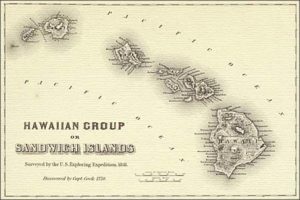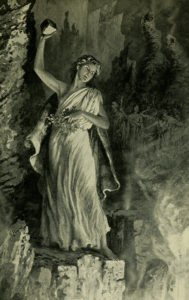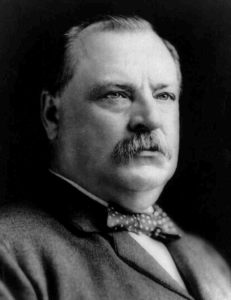 It may come as a surprise to learn that it was a prayer meeting in 1806 and the work of missionaries in 1820 followed by a major revival that began the process of bringing the Hawaiian Islands into the United States. In 1959 Congress gave its approval, in June 93% of the people of Hawaii voted to enter, and on August 21 President Eisenhower certified Hawaii as our 50th state. On July 4, 1960, the new flag of the U. S., with 50 stars, became official. But why did it take nearly 140 years?
It may come as a surprise to learn that it was a prayer meeting in 1806 and the work of missionaries in 1820 followed by a major revival that began the process of bringing the Hawaiian Islands into the United States. In 1959 Congress gave its approval, in June 93% of the people of Hawaii voted to enter, and on August 21 President Eisenhower certified Hawaii as our 50th state. On July 4, 1960, the new flag of the U. S., with 50 stars, became official. But why did it take nearly 140 years?
 During the Second Great Awakening, five Williams college students had their discussion on foreign missions interrupted by a thunder storm and ended up praying under the shelter of a haystack in 1806. The results of that meeting birthed the American Board of Commissioners of Foreign Missions (ABCFM) in 1816. Henry Opukahai’a and his friend Thomas Hopu fled their native Sandwich Islands (original name of Hawaii) in 1807. College students at Yale befriended them and won them to Christ in 1815. Henry’s Memoirs sold over half a million copies, but he died of typhus in 1818. He had written “My poor countrymen, without knowledge of the true God, and ignorant of the future world, have no Bible to read, no Sabbath.” He inspired missionaries to return to his homeland!
During the Second Great Awakening, five Williams college students had their discussion on foreign missions interrupted by a thunder storm and ended up praying under the shelter of a haystack in 1806. The results of that meeting birthed the American Board of Commissioners of Foreign Missions (ABCFM) in 1816. Henry Opukahai’a and his friend Thomas Hopu fled their native Sandwich Islands (original name of Hawaii) in 1807. College students at Yale befriended them and won them to Christ in 1815. Henry’s Memoirs sold over half a million copies, but he died of typhus in 1818. He had written “My poor countrymen, without knowledge of the true God, and ignorant of the future world, have no Bible to read, no Sabbath.” He inspired missionaries to return to his homeland!
The ABCFM sent Thomas as translator with Hiram Bingham along with Asa and Lucy Thurston to the Sandwich Islands in 1820. They were sent out from Park Street Church in Boston. Three years later, they were joined by Betsey Stockton, among others, who was the first single woman ever sent into missions from America. As an African American, she had been born into slavery, but now was a missionary to bring spiritual and natural freedom to the Sandwich Islands! Together these early missionaries created the Hawaiian alphabet, translated the Bible, taught reading, English, Latin, history and mathematics. They set up a newspaper, schools and churches and confronted drunkenness, vice and prostitution. In only a few years 8,000 students graduated from over 200 schools! By 1823 six high chiefs and Queen Kaahumanu herself were converted and wanted to be baptized!
 In the years that followed, native Hawaiians defied superstitions, stopped polygamy, spread the gospel and turned the once pagan Sandwich Islands into a Christian colony in only 25 years! One amazing example of this was the conversion and testimony of Chiefess Kapiolani. Converted by 1824, she did the unthinkable in 1825, and that was break the tabu, visiting the crater of the volcano where Pele, one of their gods supposedly lived. Accompanied by missionaries, she was told not to defy the gods. A prophetess of Pele confronted her. She defiantly ate the berries that were forbidden and declared “Jehovah is my God. He kindled these fires. I fear not Pele. Should I perish by her anger, then you may fear her power. But if Jehovah save me, when breaking her tabus, then must you fear and serve Jehovah. The gods of Hawaii are vain. Great is the goodness of Jehovah in sending missionaries to turn us from these vanities to the living God.” Unharmed, she was a catalyst for the revival to continue!
In the years that followed, native Hawaiians defied superstitions, stopped polygamy, spread the gospel and turned the once pagan Sandwich Islands into a Christian colony in only 25 years! One amazing example of this was the conversion and testimony of Chiefess Kapiolani. Converted by 1824, she did the unthinkable in 1825, and that was break the tabu, visiting the crater of the volcano where Pele, one of their gods supposedly lived. Accompanied by missionaries, she was told not to defy the gods. A prophetess of Pele confronted her. She defiantly ate the berries that were forbidden and declared “Jehovah is my God. He kindled these fires. I fear not Pele. Should I perish by her anger, then you may fear her power. But if Jehovah save me, when breaking her tabus, then must you fear and serve Jehovah. The gods of Hawaii are vain. Great is the goodness of Jehovah in sending missionaries to turn us from these vanities to the living God.” Unharmed, she was a catalyst for the revival to continue!
Though President Pierce attempted to annex Hawaii in 1854, the Senate rejected it. Many ask if the gratitude toward the U.S. for sending these missionaries was so great (and it was), why did it take so long for Hawaii to become a part of the U.S.? The continuation of revival is often hindered by the sin of man. Though missionaries from the United States were the catalysts for such a massive transformation, the U.S. also became a source of imperialism and corruption that would set back the gains of true Christian reformation by decades. Directed initially by John Quincy Adams, America’s original foreign policy was non-interventionist, seeking to send missionaries so that a nation was changed voluntarily from within and then would desire greater harmony with the U.S. During the Civil War, this began to wane and the beginnings of an imperialistic domination began. Hawaii was given “protectorate” status from 1875 to 1887, where its products were favored and it was a “territory” of the U.S.
The long standing non-interventionist policy of the U.S. meant, in practical terms, that we would not fight another nation’s revolution, nor would we force them to adopt a certain form of government. If they, on their own, did win their independence, they would have to be able to maintain their freedom on their own for a time, and adopt, voluntarily, a government in harmony with our Constitution. Then, if they were attacked, we would defend them if in this hemisphere. In essence, this was the original 1823 Monroe Doctrine. At the start of President Grover Cleveland’s second term, a treaty for the annexation of Hawaii was under consideration. But Cleveland suspected something was terribly wrong. It was.
 Beginning on the 14th of January, 1883, within 32 days, the government of Hawaii was overthrown, a Provisional government set up and the entire process of a new government and a treaty were all administered! Cleveland’s words to the nation were refreshing, but also filled with remorse and repentance for our government’s ungodly behavior. “Our country was in danger of occupying the position of having actually set up a temporary government on foreign soil for the purpose of acquiring through that agency territory which we had wrongfully put in its possession….A substantial wrong has thus been done which a due regard for our national character as well as the rights of the injured people requires we should endeavor to repair…. The law of nations is rounded upon reason and justice, and the rules of conduct governing individual relations between citizens or subjects of a civilized state are equally applicable as between enlightened nations.”
Beginning on the 14th of January, 1883, within 32 days, the government of Hawaii was overthrown, a Provisional government set up and the entire process of a new government and a treaty were all administered! Cleveland’s words to the nation were refreshing, but also filled with remorse and repentance for our government’s ungodly behavior. “Our country was in danger of occupying the position of having actually set up a temporary government on foreign soil for the purpose of acquiring through that agency territory which we had wrongfully put in its possession….A substantial wrong has thus been done which a due regard for our national character as well as the rights of the injured people requires we should endeavor to repair…. The law of nations is rounded upon reason and justice, and the rules of conduct governing individual relations between citizens or subjects of a civilized state are equally applicable as between enlightened nations.”
 After the Queen was restored to power, she traveled back to the United States to thank President Cleveland for standing up for the sovereign rights of her nation and against imperialism. A parade was held where the Queen was honored. In addition, once things were made right, the annexation of Hawaii did take place in 1898 under President McKinley. However, it was only a territory protected by the U.S. and there was no promise of Statehood. It appeared that our financial interests continued to take precedence over the self-government of the islands.
After the Queen was restored to power, she traveled back to the United States to thank President Cleveland for standing up for the sovereign rights of her nation and against imperialism. A parade was held where the Queen was honored. In addition, once things were made right, the annexation of Hawaii did take place in 1898 under President McKinley. However, it was only a territory protected by the U.S. and there was no promise of Statehood. It appeared that our financial interests continued to take precedence over the self-government of the islands.
In the decades that followed the people of Hawaii demonstrated their loyalty to the United States, fighting in wars, and desiring to have more self-government and sovereignty under the Constitution (Article IV) than comes with just being a protected territory or colony. After all, to be a colony means the U.S. gets the benefit of a monopoly on trade but there is little reciprocity for the rights of its citizens. The lesson we must learn is simple. When we injure others and apologize, true restoration means that we treat them fairly and on an equal footing. This “imperialistic” attitude demonstrated toward Hawaii in the past still lingers today in our foreign policy. In any event, may the fragrance of true repentance and forgiveness be accompanied by restitution and restoration of equal relationships in our lives!







